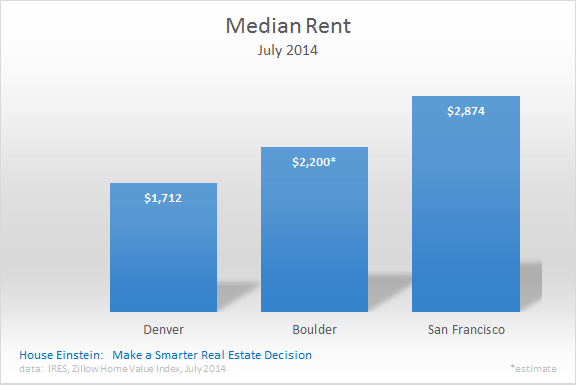Narrowing the Gap [Analyze This]
by Osman Parvez
Boulder real estate is cheap.
What’s that you say? Huh?
Oh sure, it’s pricey when you compare it to places like Omaha and Kansas City. Try comparing it to places you’d actually want to live – communities with fantastic public schools, a healthy economy, amazing weather and outdoor rec opportunities, a highly educated population, a research university, and proximity to a major airport hub. It’s a short list.
It’s no secret why Boulder keeps attracting new residents (here’s why). Despite the relentless demand, we’re not building significant amounts of new housing within city limits. This isn’t going to change (thankfully). High demand and constrained supply = higher prices. It’s economics 101.
Boulder is cheap when you compare it to other places you might consider living. The more interesting question is how much and by how far has the gap narrowed with other desirable cities.
Take a look at the following charts.
You’re looking at the median price for homes sold in the Denver MSA, Boulder, and San Francisco during July, 2014.
Why San Francisco? To be honest, it’s a place I’d consider living if I weren’t so infatuated with Boulder. I’m also going on a trip there in a few weeks and I want to write it off I’m doing a little homework on the community.
San Francisco is the center of our nation’s technology industry, a hub of entrepreneurs and established tech giants. It’s a great place to start a company. Boulder has plenty of tech and a higher percentage of early stage companies. It’s also widely recognized as a great place to start a company (see How Boulder Became America’s Startup Capitol).
Note: Data sources for the chart above include IRES for Boulder and Zillow’s Home Value Index for Denver and San Francisco Yes, I’ve bashed the big Z several times in the past but they have also quietly been improving the quality of their data – enough so to include the Denver ZHV index at least (see Zillow Continues to Mislead for why you shouldn’t trust their Boulder data, however).
Keep in mind that the Denver MSA includes parts of Aurora and Lakewood you may not want to live in, not just the hip urban downtown center.
The Denver MSA is about 43% less expensive than Boulder and San Francisco is 45% more expensive. No surprise to anyone who has shopped for a home in both (shout out to you, Ben.)
This next chart shows median rent. Compared to Boulder, San Francisco is 31% more expensive. The Denver MSA is 22% less expensive.
Note: Rental data for Denver and San Francisco is from Zillow. Finding solid data for the Boulder rental market is challenging (even for me). $2200 per month is an educated guess based on my market knowledge and assuming a typical 3 bedroom house in an average location worth about $475,000.
These last two charts look at affordability and how it has changed over time.
The first one is based on data that Zillow published last month. They’re taking median income from the US Census American Community Survey and simply showing what share of income would go towards the monthly payment on the median price house. For comparison purposes, the bars above show the current share (brown) vs. the historic period (green)of 1995 to 1999 – prior to the real estate bubble.
The Denver MSA has gotten a little more affordable. If you bought a median priced house during the pre-bubble historic period, 21.6% of the median income would go towards your mortgage. Today that share is down to 18.9%.
San Francisco has gone the other direction. The monthly payment on a median price house has increased from 37.7% to 42.6% of the local median income.
It’s safe to say that Boulder is somewhere in the middle, not quite nose-bleed prices of San Francisco but also not as cheap as the Denver MSA.
note: Don’t ignore the difference in down payment. In addition to the higher monthly carrying cost, you’d need to come up with $43,320 more in San Francisco than in Boulder – at the median.
Here’s the same chart for renters. At the median, the portion of income that is going to rent has increased from 21.6% to 31.8% for the Denver mSA and from 28.1% to a eye popping 43.3% for San Francisco. Not only has the relative cost for renting increased to a much larger share, vacancy is at near historic lows (read: Average Rent Spikes 17% in Ft. Collins, Boulder).
Final Thoughts
Boulder is far more affordable than the benchmark San Francisco. If it’s not within reach of your budget, there are solid options within easy commuting distance (Broomfield, Erie, and Longmont for example). From an investment perspective, Longmont in particular is set to boom. I’ll save that for another post.
Entrepreneurship requires a healthy mix of talent and capital. Entrepreneurs also want to live in a place that is overflowing with outdoor recreation opportunities, has fantastic weather, and is a magnet for creative talent. There’s a reason it’s happening here.
—
As always, your referrals are deeply appreciated.
Narrowing the Gap [Analyze This]
by Osman Parvez
Boulder real estate is cheap.
What’s that you say? Huh?
Oh sure, it’s pricey when you compare it to places like Omaha and Kansas City. Try comparing it to places you’d actually want to live – communities with fantastic public schools, a healthy economy, amazing weather and outdoor rec opportunities, a highly educated population, a research university, and proximity to a major airport hub. It’s a short list.
It’s no secret why Boulder keeps attracting new residents (here’s why). Despite the relentless demand, we’re not building significant amounts of new housing within city limits. This isn’t going to change (thankfully). High demand and constrained supply = higher prices. It’s economics 101.
Boulder is cheap when you compare it to other places you might consider living. The more interesting question is how much and by how far has the gap narrowed with other desirable cities.
Take a look at the following charts.
You’re looking at the median price for homes sold in the Denver MSA, Boulder, and San Francisco during July, 2014.
Why San Francisco? To be honest, it’s a place I’d consider living if I weren’t so infatuated with Boulder. I’m also going on a trip there in a few weeks and I want to write it off I’m doing a little homework on the community.
San Francisco is the center of our nation’s technology industry, a hub of entrepreneurs and established tech giants. It’s a great place to start a company. Boulder has plenty of tech and a higher percentage of early stage companies. It’s also widely recognized as a great place to start a company (see How Boulder Became America’s Startup Capitol).
Note: Data sources for the chart above include IRES for Boulder and Zillow’s Home Value Index for Denver and San Francisco Yes, I’ve bashed the big Z several times in the past but they have also quietly been improving the quality of their data – enough so to include the Denver ZHV index at least (see Zillow Continues to Mislead for why you shouldn’t trust their Boulder data, however).
Keep in mind that the Denver MSA includes parts of Aurora and Lakewood you may not want to live in, not just the hip urban downtown center.
The Denver MSA is about 43% less expensive than Boulder and San Francisco is 45% more expensive. No surprise to anyone who has shopped for a home in both (shout out to you, Ben.)
This next chart shows median rent. Compared to Boulder, San Francisco is 31% more expensive. The Denver MSA is 22% less expensive.
Note: Rental data for Denver and San Francisco is from Zillow. Finding solid data for the Boulder rental market is challenging (even for me). $2200 per month is an educated guess based on my market knowledge and assuming a typical 3 bedroom house in an average location worth about $475,000.
These last two charts look at affordability and how it has changed over time.
The first one is based on data that Zillow published last month. They’re taking median income from the US Census American Community Survey and simply showing what share of income would go towards the monthly payment on the median price house. For comparison purposes, the bars above show the current share (brown) vs. the historic period (green)of 1995 to 1999 – prior to the real estate bubble.
The Denver MSA has gotten a little more affordable. If you bought a median priced house during the pre-bubble historic period, 21.6% of the median income would go towards your mortgage. Today that share is down to 18.9%.
San Francisco has gone the other direction. The monthly payment on a median price house has increased from 37.7% to 42.6% of the local median income.
It’s safe to say that Boulder is somewhere in the middle, not quite nose-bleed prices of San Francisco but also not as cheap as the Denver MSA.
note: Don’t ignore the difference in down payment. In addition to the higher monthly carrying cost, you’d need to come up with $43,320 more in San Francisco than in Boulder – at the median.
Here’s the same chart for renters. At the median, the portion of income that is going to rent has increased from 21.6% to 31.8% for the Denver mSA and from 28.1% to a eye popping 43.3% for San Francisco. Not only has the relative cost for renting increased to a much larger share, vacancy is at near historic lows (read: Average Rent Spikes 17% in Ft. Collins, Boulder).
Final Thoughts
Boulder is far more affordable than the benchmark San Francisco. If it’s not within reach of your budget, there are solid options within easy commuting distance (Broomfield, Erie, and Longmont for example). From an investment perspective, Longmont in particular is set to boom. I’ll save that for another post.
Entrepreneurship requires a healthy mix of talent and capital. Entrepreneurs also want to live in a place that is overflowing with outdoor recreation opportunities, has fantastic weather, and is a magnet for creative talent. There’s a reason it’s happening here.
—
As always, your referrals are deeply appreciated.
Share This Listing!
More about the author
Osman Parvez
Owner & Broker at House Einstein as well as primary author of the House Einstein blog with over 1,200 published articles about Boulder real estate. His work has appeared in the Wall Street Journal and Daily Camera.
Osman is the primary author of the House Einstein blog with over 1,200 published articles about Boulder real estate. His work has also appeared in many other blogs about Boulder as well as mainstream newspapers, including the Wall Street Journal and Daily Camera. Learn more about Osman.
Work with
House Einstein
Thinking about buying or selling and want professional advice?
Call us at 303.746.6896
Your referrals are deeply appreciated.

















